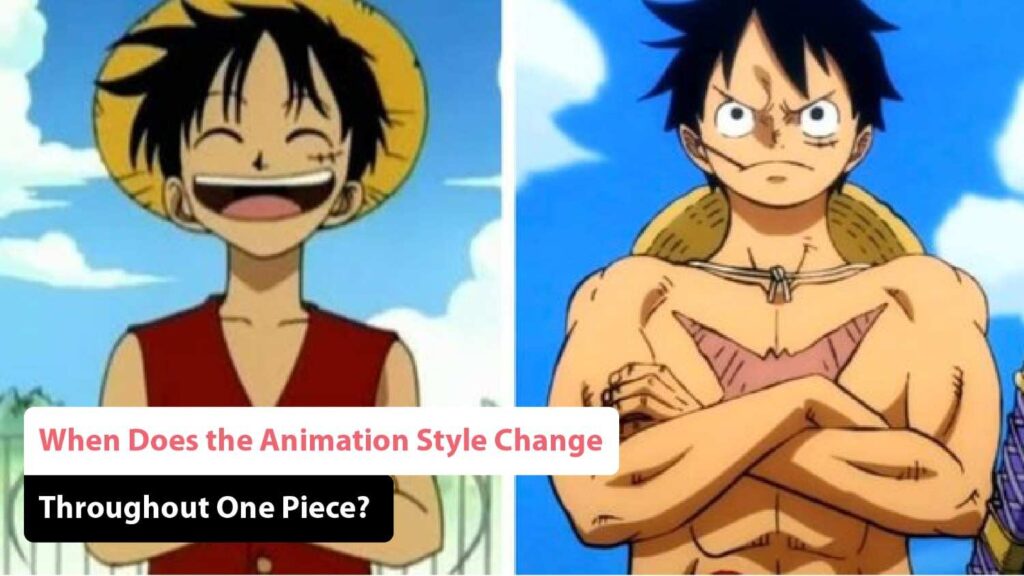
In “One Piece,” the animation style evolves notably throughout its run. Early episodes (1999-2001) feature a more simplistic and less detailed style, reflecting the budget and technology of the time. From 2002 onwards, the animation quality improved with more fluid movements and refined character designs. The 2010s saw further enhancements with sharper visuals and more dynamic action sequences, particularly noticeable during key arcs like “Marineford” and “Dressrosa.” The animation continues to advance with each new arc, offering increasingly detailed backgrounds and more sophisticated character animation, reflecting both technological progress and the series’ growing budget.
In this blog, we’ll take a detailed look at the One Piece animation evolution timeline, exploring the best and worst One Piece animation styles, understanding Toei Animation’s style shift in One Piece, and pinpointing the major upgrades that define each era
Why Animation Style Shifts Matter in Long-Running Anime
Before diving into the specifics, it’s worth noting why these changes are significant.
Animation isn’t just about aesthetics—it affects pacing, emotional impact, fight choreography, and how viewers engage with the story. In One Piece, style changes often align with production improvements, budget increases, and major arcs that demand higher visual standards.
And in a series this long, visual upgrades keep things fresh. They also mark major milestones in the series’ narrative and production.
Now, let’s explore the One Piece animation changes by arc.
One Piece Animation Evolution Timeline: Key Style Shifts
Here’s a comprehensive breakdown of the One Piece animation evolution timeline, covering every major visual shift throughout the series.
1. East Blue to Alabasta Arc (Episodes 1–130) – The Classic Era
This era features Toei’s late-90s animation—thicker outlines, muted color palettes, and simpler character designs. Movements were more limited, and backgrounds less detailed, but it matched the manga’s whimsical tone well.
✔️ Strengths: Faithful to Oda’s art style, nostalgic
❌ Weaknesses: Choppy animation, off-model faces
This is widely considered part of the “classic” look and is a staple in the One Piece animation evolution timeline.
2. Skypiea to Water 7 Arc (Episodes 131–325) – Slight Refinements
Toei began improving animation fluidity here, with brighter color palettes and smoother shading. Characters started looking more consistent, especially during key scenes like the fight between Luffy and Enel or the Water 7 confrontations.
✔️ Strengths: Cleaner line work, better emotional expressions
❌ Weaknesses: Still relied heavily on still frames for action
The One Piece animation changes by arc during Water 7 are subtle, but noticeable.
3. Enies Lobby Arc (Episodes 264–312) – Fluid Action Peaks
This arc features one of the first big boosts in animation quality. Fight scenes, especially Luffy vs. Lucci, received more frames, better choreography, and cinematic angles. It marked a turning point in production quality.
✔️ Strengths: Top-tier sakuga moments, dramatic lighting
❌ Weaknesses: Inconsistent across episodes
Many fans regard this as one of the best One Piece animation styles of the pre-timeskip era.
4. Thriller Bark to Marineford (Episodes 337–516) – Sharpness Overhaul
This era introduced sharper character designs and increased digital shading. Colors became richer, and the Marineford arc showcased more detailed battle scenes and layered compositing.
✔️ Strengths: More dramatic tone, intense war scenes
❌ Weaknesses: Occasional off-model animation in filler episodes
Marineford was a key moment in the Toei Animation style shift in One Piece, blending the old style with more cinematic elements.
5. Post-Timeskip (Episodes 517–589) – New World, New Look
With the time skip came new character designs and a significant art style overhaul. Faces were drawn with slimmer lines, environments were more textured, and battles became more strategic in direction and pacing.
✔️ Strengths: More modern look, stronger consistency
❌ Weaknesses: Some arcs looked static due to budget constraints
The Fish-Man Island and Punk Hazard arcs reflect the early attempts at refining the new look, but they didn’t yet match the fluidity of the manga panels.
6. Dressrosa Arc (Episodes 629–746) – Stylized Action
This era features some of the most polarizing visuals in One Piece history. While the art style evolved again—with sharper shadows, elongated expressions, and heavier line work—the pacing slowed down, and animation quality became inconsistent.
✔️ Strengths: Stylized drama, unique visual identity
❌ Weaknesses: Overuse of static frames, long reaction shots
Dressrosa is often cited as one of the worst One Piece animation styles, not due to art direction but due to pacing and budget allocation.
7. Whole Cake Island Arc (Episodes 783–877) – A Cinematic Step Forward
Here, the visuals take a major leap. The cake city, mirror world, and emotional storytelling allowed animators to flex their creativity. Smooth camera transitions, deeper color grading, and more expressive character animation all became the norm.
✔️ Strengths: Visually inventive, strong emotional beats
❌ Weaknesses: Filler episodes showed noticeable drop in quality
Whole Cake Island marked a pivotal stage in the One Piece animation evolution timeline, previewing what was coming in Wano.
The Big Leap: One Piece Wano Arc Animation Quality
Enter the Wano arc—arguably the biggest stylistic upgrade in One Piece history.
Wano, which began at Episode 892, set a new standard for Toei. It featured cinematic direction, sakuga-packed fight scenes, modern compositing techniques, and vibrant Japanese-inspired backgrounds. The visual overhaul was immediate and widely praised.
✔️ Strengths:
- Dynamic camera work
- Movie-level sakuga (Luffy vs. Kaido, Zoro’s Asura, Gear 5)
- Stylized brushstroke effects and bold color grading
❌ Weaknesses: Some viewers found the high saturation or intense sakuga jarring in less dramatic scenes.
Still, there’s no denying the One Piece Wano arc animation quality is in a league of its own. It not only modernized the show but elevated it to cinematic levels worthy of theatrical releases.
This arc represents the culmination of the Toei Animation style shift in One Piece—a true transformation of how the studio approaches long-form storytelling, art direction, and fight choreography.
What’s Next? Post-Wano Animation in 2025
As of 2025, One Piece has entered its final saga, and the animation has maintained Wano-level quality while refining direction and consistency.
Notably:
- Egghead Island is rendered with a more sci-fi palette, cooler tones, and tech-inspired design.
- Fight scenes are more evenly distributed in quality across episodes.
- Facial animation has become more expressive, mirroring Oda’s manga more faithfully than ever before.
This current era blends the strengths of Wano with more controlled pacing and subtle stylistic polish, continuing the legacy of top-tier One Piece animation changes by arc.
Best and Worst One Piece Animation Styles (Ranked by Fans)
Based on community consensus and visual analysis, here’s how fans generally rank the best and worst One Piece animation styles:
✅ Best Styles:
- Wano Arc (Episodes 892–1060+)
- Enies Lobby Arc (Episodes 264–312)
- Whole Cake Island (Episodes 783–877)
❌ Worst Styles:
- Dressrosa Arc (Episodes 629–746) – Beautiful at times, but hurt by extreme pacing.
- Fish-Man Island (Episodes 517–574) – Inconsistent animation with underwhelming battle direction.
- Early East Blue (Episodes 1–61) – Classic but outdated by modern standards.
Final Thoughts
The animation journey of One Piece is a fascinating visual evolution that mirrors the growth of its characters and narrative. From the rough, heartfelt lines of the East Blue to the explosive sakuga of Wano and the crisp visuals of Egghead, the series has matured beautifully.
Understanding the One Piece animation changes by arc not only helps fans appreciate the craft but also gives insight into how Toei adapts, innovates, and delivers across decades. Whether you love the nostalgic charm of the early days or the jaw-dropping spectacle of modern episodes, each style has played a role in shaping the identity of this legendary series.
So, if you’re rewatching or catching up in 2025, keep an eye on the One Piece animation evolution timeline—because it’s not just the story that grows… it’s the entire world.
Frequently Asked Questions (FAQ’s)
When did the animation in One Piece start to change?
The animation quality in One Piece began to change noticeably after the early seasons. As the series progressed, factors such as tight production schedules, evolving animation standards, and changes in the production team contributed to variations in animation quality. Additionally, the increasing popularity of the series led to higher expectations, pushing the animation teams to adapt and refine their techniques over time. This ongoing evolution reflects both the challenges of long-term production and the series‘ commitment to delivering engaging visuals.
Why does the animation quality vary in One Piece?
Several factors contribute to the variation in animation quality:
- Production Deadlines: The demand for new episodes can lead to compromises in animation quality due to tight schedules.
- Team Changes: New animators and directors bring different styles, affecting the consistency of animation.
- Budget Constraints: Fluctuations in budget and time available for each episode can impact quality.
- Technological Advances: Shifts from traditional to digital animation have also influenced the visual style.
How do production schedules affect animation quality?
Tight production schedules often require quick turnaround times for episodes. This can lead to variations in animation quality, as animators might have less time to refine each scene, resulting in less detailed or inconsistent animation. These constraints can also limit the ability to address intricate details and smooth transitions, impacting the overall visual consistency. Despite these challenges, the series continues to adapt, striving to maintain its visual appeal and storytelling quality.
Which studio was responsible for the early animation of One Piece?
Toei Animation was responsible for the early animation of One Piece. They adapted Eiichiro Oda’s manga into the anime format and set the initial tone and style of the series. Their work established the distinctive visual identity that fans still recognize and cherish today. Despite evolving techniques and styles, Toei’s foundational influence remains a key element of the series’ enduring charm. Their early contributions helped shape the beloved aesthetic that continues to define One Piece.
Have there been any notable improvements in animation quality?
Yes, there have been notable improvements in animation quality over the years. Advances in digital technology have allowed for smoother and more dynamic animations. Special episodes and films, such as those produced for the One Piece movies, often feature higher-quality animation. These high-budget productions enable the use of cutting-edge techniques and tools, elevating the visual experience and showcasing the series’ commitment to delivering stunning visuals.





